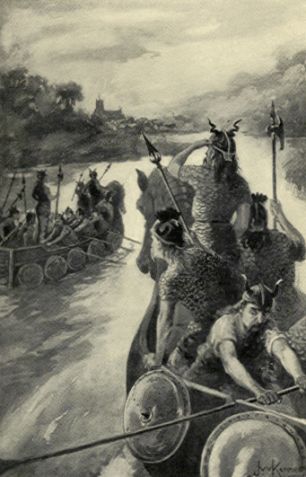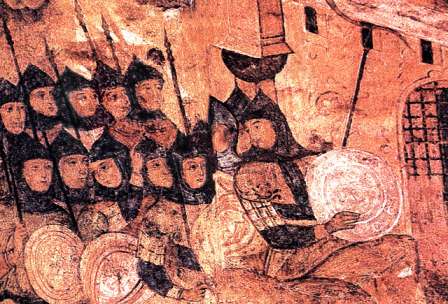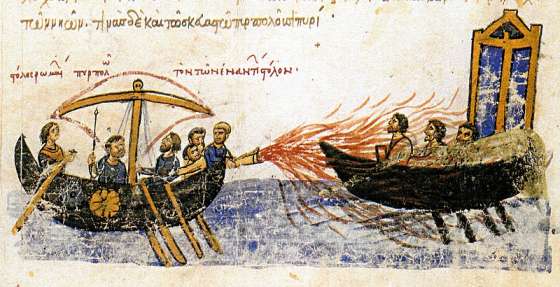Fierce Vikings, mainly from Sweden, spread throughout all of Eastern Europe. They came to be known as “The Rus.” The name is derived from a Finnish word meaning “rowers.” Viking longships and their warrior crews made an impression from Ireland to Russia and to Constantinople.
The Rus were warriors but they were also traders. When they started their journey into the lands of Russia and Ukraine, the Rus began to think it would be possible to reach the richest city on Earth, Constantinople. There they would trade with its wealthy inhabitants. Constantinople was a trade hub – goods from all over the known world flooded into it and out of it.
The Viking Rus meet the Romans
Fierce Vikings from Sweden: “The Rus.” The name is derived from a word meaning “rowers.” Viking longships and their warrior crews made a lasting impression on Iceland, Britain and Ireland to Russia and Constantinople.
The Rus were warriors, but they were also traders. Soon after they started their journey into the lands of Russia and Ukraine, the Rus thought it would be possible to reach the richest city on Earth, Constantinople. There they would trade with its wealthy inhabitants. Constantinople was a trade hub – goods from all over the world flooded into and out of it.
Vikings trade in Russia and Ukraine

Jewels, jewelry, furs, silver, and slaves were just some of the things the Vikings wanted. Before they became known as “The Rus,” the Vikings of Sweden had heard rumors of a great city and empire to the south on the coast of the Black and Mediterranean seas. They found evidence of great wealth not far from their home territory near Lake Ladoga, part of which borders St. Petersburg, Russia today. St. Petersburg wasn’t built until the early 18th century, but there were trading stations on the coast of Ladoga. There, the Vikings found what they most prized – silver in the form of “dirhams,” a coin of purer silver than the Vikings had ever dreamed. Silver drove the Rus southward.
Viking Rus and the Slave Trade
The slave trade also drove the Vikings south. Slaves by the tens of thousands or more. The lands of Russia and Ukraine are vast, and there were powerful tribes that challenged the Rus Vikings many times. Most people lived in relatively isolated villages or nomadic camps, however – which were often relatively defenseless. Making things worse for the average person, the many tribes of the region often fought against each other. Captured enemies were sold as slaves.
Who was “the Rus”? Mostly Swedes
The Rus were mainly Swedish Vikings drawn into the forests and plains to the east of their homeland. Norwegian, Danish, and Baltic Vikings were among them. From the 9th and 10th centuries, the Rus traveled east into present-day Russia, Ukraine, and Belarus. Today, they reach out from the afterlife centuries after they passed into history.
Today, pundits and propagandists in Russia push the narrative that their nation is the inheritor of the Rus, not Ukraine. On the other hand, the Ukrainians are keen to point out that history calls the Vikings in the East the “Kyivan Rus.” These Swedish “immigrants” founded Kyiv before Moscow was even a village. One thing is sure – Vikings founded a large empire in today’s western Russia and Ukraine and used it as a center of power and trade.
The great Byzantine Empire
In 330, the Roman emperor Constantine founded the new capital of the Roman Empire at Byzantium. The city soon took on his name: “Constantinople.” One hundred years later, the Roman Empire officially split into two parts, the Western and Eastern Roman empires. The Eastern Roman Empire is often called “The Byzantine Empire” from the original name of the capital city. Constantinople is called Istanbul today and is Turkey’s largest city. But the Turks did not move into the area until the 11th century. It was not until 1453 that Constantinople and the Byzantine Empire finally fell to them.
Clash of Cultures
Many of the empire’s leading citizens and emperors were Greeks or Romans. These people had taken on the Greek language and culture. By the time the Rus arrived, the Byzantine Empire was four or five hundred years old. Constantinople became a great city when the Swedes were semi-nomadic forest and coast dwellers in the isolated frozen north.
The Byzantines controlled much of the North African coast, the Balkan Peninsula, Asia Minor, and a large part of the western Middle East. They also held the southern coast of the Black Sea and had trading stations and garrisons on the north coast. There, they traded and fought with the tribes of the area, including the Pechenegs, a large and powerful tribe. The Pechenegs fought with and against the Rus at times.
Rurik and Oleg
The first ruler of the Rus is believed to be a Scandinavian prince named “Rurik.” The strong Rurik was invited by the people in the area of today’s Russian city of Veliky Novgorod in the early 860s. By the late 800s, Rurik’s comrade, known by the Slavic name of “Oleg,” became the first true ruler of the Rus. He founded his capital where today’s Kyiv lies. The Rus had almost become a people in and of themselves, separate from their homelands in Scandinavia. However, it was not until much later that the traces of their Viking roots faded with their adoption of Christianity.
Oleg had murdered his two brothers to become King of the Rus. To further cement his hold on power and to make his growing kingdom richer, he sought ties with the Byzantines. Especially twith hose in Constantinople, which the Vikings called “Miklagardr,” or “big stronghold.”
Early Signs of Contact
Evidence shows that the eastern Vikings had had contact with Byzantium before Rurik and Oleg. In 839, a diplomatic envoy from the Byzantine emperor Theophilus (r. 829-842) and his entourage arrived at the court of Louis I. He was then the emperor of Frankia and son of Charlemagne. With the diplomat were men who called themselves “Rhos.” “The Rhos” were Rus Vikings who their chief had sent to establish relations with the Franks.
That being the case, we know that the Rus and the Byzantines had contact with each other before Rurik and Oleg. Louis, it turns out, kept the Rus around a while. He eventually found out the “Rhos” were Swedes – and Louis was very familiar with Swedes – they were Vikings. Louis was not a fan, and we don’t know what, if anything, happened to these “Rhos.”
Trade Preceded Direct Contact
We also know that the Rus, or the Swedes, knew of the Byzantines long before their two peoples began contact in the second half of the 9th century. In a village on the shores of Lake Ilmen, which lies across the borders of Russia and northern Belarus, archaeologists discovered a coin with Theophilus’ face and title dating from his reign, which ended almost two decades before the Vikings established relations with Byzantium. Also found was an official seal of Theophilus. These have also been found at known Viking trading sites in Sweden.
There were trading and diplomatic relations between the Rus and the Byzantines before 860. For a long time, they seemed to be going reasonably well. By 860, however, the Vikings had had a really good look at exactly how wealthy Constantinople was.
The Vikings attack Constantinople
It seems as if the Rus, being Vikings, could not resist such a prize. Apparently, the Rus did not intend to occupy Constantinople but raid it and take as much of their wealth as their longboats could carry. It must have been a significant force, for Constantinople was perhaps the biggest city in Europe at the time.
The Rus also knew that the Byzantine emperor, Michael III (r. 842-867), and his main armies were in southern Turkey dealing with the Arabs, who were expanding their empire under the green flag of Islam. Their fleets, almost invincible on the sea due to their use of “Greek fire,” were also busy elsewhere, fighting enemies to the west near Greece.
The Element of Surprise
The Vikings also had the element of surprise on their side – after a decade or more of good relations, no one expected them to attack. What’s more, why would they? They had good trade relations with the Byzantines and had, at times, fought hostile tribes on the northern Black Sea coast together. Perhaps that’s what Michael was thinking.
The Vikings attacked “Miklagardr” on June 18, 860. A large Rus fleet of about 200 longboats sailed into the Bosporus Straits between the Black Sea and the Mediterranean. Towns outside the city were sacked, killing many inhabitants. The islands off the city’s coast, dubbed “The Princes Islands” because they were used to exile rivals within the royal family, were also sacked.
Archbishop Photios, in charge of the city’s defenses, could do nothing but pray and hope that God would intervene. Finally, on August 4th, the Vikings left, never having entered the city but essentially destroying everything around it.
After a month and a half of this, their leaving could hardly be called “an act of God.” However, that is what Photios claimed it was: August 4th became a holy day until the end of the empire in 1453.
Kyiv was a Viking capital
The riches that the Vikings and Oleg took likely later contributed to Oleg moving his seat of power from Novgorod to the city of Kyiv in Ukraine Kyiv has better access to several vital river routes.
Oleg is said to have greatly expanded the city and its defenses. The Rus are known to history from this time forward as the “Kievan Rus,” though “Kyiv” is the correct Ukrainian name.
The Rus are met with “Greek fire”
“Greek fire” was a flammable compound of naphtha and quicklime. Barrels or large kettles of Greek fire were ready on the walls of Constantinople and the Byzantines’ ships. The Rus knew of this weapon but had not experienced it.
When they attacked Constantinople again, this time in 941, under Rurik’s grandson, Ivan of Kyiv, the Rus got more than an idea of what “Greek fire” could do, especially to their wooden ships.
Additionally, it’s said that the mixture would burst into flame when it came in contact with water. This meant that the Byzantine ships did not have to get close to their enemies. They had large flume-like appendages on the front and rear of their ships from which Greek fire could be launched.
The spout did not even have to strike the Rus ships directly – just the water around it. Much the same happened to the vessels that tried to approach the city walls.
Raiding, pillaging and executions
Though the city remained safe, much of the surrounding area was raided, pillaged and burnt to the ground. The Rus carried out mass executions within sight of the city walls in an attempt to cow its inhabitants. The arrival of a naval relief force from another part of the empire halted the Rus’ atrocities. The Rus retreated across the straits to Thrace laden with booty, but many of their ships were destroyed by the Byzantines.
Peace between the Vikings and the Eastern Roman Empire
As you can imagine, Igor and the rest of the Vikings were not too happy about the events in 941. Three years later, a much larger fleet returned to the coast of Constantinople. This time it seems that sense prevailed on both sides, for they entered into negotiations and signed a peace treaty that provided both sides with guarantees.
Princes Oleg and Igor were among the first Rus to have Slavic names. We know Igor had a Slavic mother. Oleg may or may not have. However, the Rus-Byzantine Treaty still exists. On it are dozens of signatures – those of the Rus include not only typically Swedish names, but Danish, Norwegian and three Finns. The three important Slavic names are Igor, his son Sviatoslav and a man named Predslava. Full assimilation of the Vikings obviously did not take place until some time in the future.
Featured Image Credit: Nicholas Roerich, Public domain, via Wikimedia Commons


